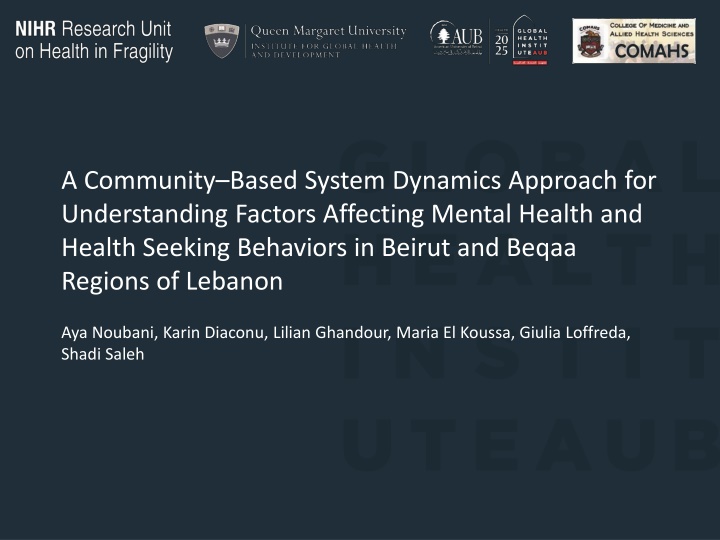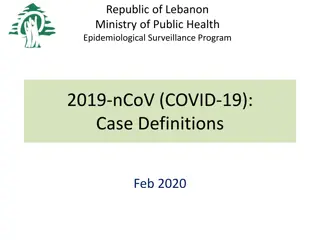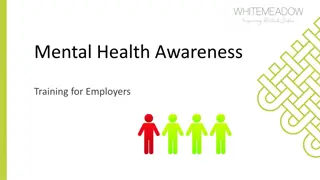Factors Influencing Mental Health in Lebanon
This research explores the global burden of mental health disorders, treatment disparities, and the specific case of Lebanon, focusing on the impact of demographic shifts and the fragile health system. The study aims to identify factors affecting mental health and health-seeking behaviors in the Beirut and Beqaa regions. It sheds light on the treatment gaps and significance of addressing mental health issues in the context of a LMIC like Lebanon.
Uploaded on Mar 13, 2025 | 1 Views
Download Presentation

Please find below an Image/Link to download the presentation.
The content on the website is provided AS IS for your information and personal use only. It may not be sold, licensed, or shared on other websites without obtaining consent from the author.If you encounter any issues during the download, it is possible that the publisher has removed the file from their server.
You are allowed to download the files provided on this website for personal or commercial use, subject to the condition that they are used lawfully. All files are the property of their respective owners.
The content on the website is provided AS IS for your information and personal use only. It may not be sold, licensed, or shared on other websites without obtaining consent from the author.
E N D
Presentation Transcript
A CommunityBased System Dynamics Approach for Understanding Factors Affecting Mental Health and Health Seeking Behaviors in Beirut and Beqaa Regions of Lebanon Aya Noubani, Karin Diaconu, Lilian Ghandour, Maria El Koussa, Giulia Loffreda, Shadi Saleh
RESEARCH TEAM Aya Noubani 1, Karin Diaconu 2, Lilian Ghandour 3, Maria El Koussa 1, Giulia Loffreda 2, Shadi Saleh 1 1 Global Health Institute, American University of Beirut, P.O. BOX 11-0.236 Riad El Solh, 11072020 Beirut, Lebanon 2 Institute for Global Health and Development, Queen Margaret University, Edinburgh, Scotland, EH21 6UU 3 Department of Epidemiology and Population Health, Faculty of Health Sciences, American University of Beirut, P.O. BOX 11-0.236 Riad El Solh, 11072020 Beirut, Lebanon
OUTLINE Background Global burden of Mental Health Disorders Disparities in outcome and quality of care Burden of MH in Lebanon: Host and Syrian community Treatment Gaps Significance and Objectives Methods Results Conclusions and Recommendations
GLOBAL BURDEN OF THE DISEASE Mental illness, is defined as a group of disorders characterized by some combination of abnormal thoughts, emotions, behaviours, and relationships with others 7% of all global burden of disease as measured in DALYs and 19% of all years lived with disability were caused by mental and addictive disorders Individuals with these disorders were found to face increased rates of morbidity from general medical conditions
DISPARITIES IN OUTCOME OF TREATMENT A disproportionate number of affected individuals remain untreated - especially in low and middle-income countries (LMICs) LMICs often have limited healthcare resources with over 75% of mentally ill patients remaining untreated due to a shortage of mental health services
LEBANON: OVERVIEW Lebanon is a LMIC in the Eastern end of the Mediterranean Sea Lebanon Syria Fragile Health System Occupied Palestine Highest number of refugees per capita in the world Demographic shift had a considerable impact on the country s health system, economy, employment and infrastructure
Burdenof Mental Health in Lebanon There is lack of epidemiological data on the prevalence and burden of mental health disorders in the population of Lebanon 25.8% of a cohort of adults aged 18 or older at least one disorder and that 10.5% had experienced more than one disorder. Anxiety was most prevalent (16.7%), followed by mood disorders (4.9%) A minority of those with a mental health disorder received professional treatment.
Burden of Mental Health in Lebanon Burden among Syrian Refugees Burden among Syrian Refugees 12% of the surveyed refugee households had experienced a physical or mental disability 3% of households reported one or more residents in need of mental care Minorities have sought professional treatment Difficulties in accessing services were due to the cost of treatment, consultation fees, and not knowing where to seek help
AIMS OF THE STUDY Given the limited evidence on the underlying factors of mental health and the treatment gap Examine how Lebanese host and Syrian refugee communities perceive mental health and mental health problems Understand the dynamics of health seeking behaviours of both populations and the main issues faced by users in their health seeking and treatment journey Findings will inform Lebanon s national mental health strategy and its aims
STUDY DESIGN The study consisted of: 1) Semi-structured interviews 2) Four Group Model Building (GMB) workshops Qualitative comparative study design Two different areas : Beirut vs Bekaa Two different populations: Syrians & Lebanese Gender sensitive groups Ethical approval was obtained from the Institutional Review Boards at the American University of Beirut (AUB) and Queen Margaret University (QMU)
STUDY LOCATION The study was conducted in two contrasting fragile contexts in Lebanon 1. The highly urbanized Beirut area 2. The rural areas of Beqaa Beirut Bekaa areas Hosts 24% of Syrian Refugees Hosts 36% of Syrian Refugees Lowest poverty rates (16%) Highest poverty rates (38%) Has most of the health institutions In need of major health institutional support
SAMPLING STRATEGY AND RECRUITMENT TARGET POPULATION Non probability sampling Recruitment Have an interest in MH conditions Gender and age balanced NGOs active in delivering MHPSS services Purposive Caretakers of people with MH issues Primary health Care centers Convenience Adults above 18 Snowballing UNHCR
Data Collection and Analysis: Semi Structured Interviews Data Collection and Analysis: Semi Structured Interviews Interviews were semi-structured and included questions on Perceptions of seeking treatment from the health system and its barriers Help seeking behaviors and factors shaping these routes Defining mental health and its causes Society s perception of MH Thematic Analysis was conducted Two researchers read the transcripts and open coded a sample of transcripts Inter-rater reliability testing was done (K=80%) Developed a coding framework Analyses were done in Dedoose
DATA COLLECTION AND ANALYSIS: GROUP MODEL BUILDING 1. Rich Pictures 2. Graphs and Trends
DATA COLLECTION AND ANALYSIS: GROUP MODEL BUILDING Connections between the variables as described by participants in their initial concept models were translated into an electronic model using the bespoke software VenSim models developed across the different workshops and groups were compared Information from these models were further consolidated into one overarching causal loop diagram 3. Concept Model
Three Three thematic areas emerged thematic areas emerged from the data collected from the data collected 1. Perceptions of mental health problems Causes of mental health issues including the gender differences 2. Health seeking behaviours and practices to maintain wellbeing 3.
Perceptions of Mental Health Problems Mental health problems are highly stigmatized, but inconsistencies are evident Individuals with mental health issues are severely stigmatized: those affected are labeled crazy and avoided because they cannot be taken seriously. They don t view them positively. They would consider them crazy and as if they are less than human A Syrian woman residing in Beirut Most of the participants mentioned that they are against social stigma and discriminatory behavior It should be normal and without pressure. Society should reduce the person s burden. A Syrian women living in Beqaa Many discussed the importance of seeking help from a therapist and normalized this practice.
Causes of Mental Health Issues When discussing the onset of mental health issues, participants identified diverse drivers and risk factors 1. Long term effects of exposure to war and violence (Blue Zone) 2. Integration challenges resulting from the political and social effects of war (orange Zone) 3. Socioeconomic constraints (Green Zone) 4. Gendered expectations driving onset of mental health issues (yellow zone)
Causes of Mental Health Issues Causal Loop Diagram Culture and environment Trauma experienced due to war and conflict + + + + Sexual harassment and discrimination towards women Exposure to violence, torture, violence against women and children After-effects of Lebanese war Losses experienced (e.g. of loved ones, family) Insecurity of the Syrian conflict + + + + + + Number or traumatic events experienced + Violence in the household and family Displacement of Syrian refugees Presence of intergenerational trauma + Levels of anxiety associated with worrying over loved ones and safety + + Governance challenges in Lebanon Level of physical illness (personal or household) - + + + + + + Availability of a stable home environment + Family ability to manage episodes of illness Integration challenges including discrimination between communities and adaptation to foreign context + - + + - + + + - Stress at individual and household levels Political tension in country Level of worries associated with children (schooling, maturity, gaming) Ability to access health care + Persons experiencing MHPSS issues + + + - - Ability to afford care + Level of worries of mothers in relation to child rearing + Challenges in managing gender-related expectations Ability to secure adequate nutrition for ones family Preferences towards waiting (Islamic doctrine) Availability of jobs for the Syrian and Lebanese communities + + + + + + - + Availability of finances at household levels + Level of worry of fathers in relation to providing for family + Feeling trapped in a daily routine and life - + + Social inequality - - - - Ability to meet family obligations Ability to secure employment - Ability to meet aspirations for a better life (individually and family) + + Ability to better ones economic station +
Long term effects of exposure to war and violence (Blue Zone) Culture and environment Trauma experienced due to war and conflict + + + + Sexual harassment and discrimination towards women Exposure to violence, torture, violence against women and children Trauma experienced due to war and conflict Losses experienced (e.g. of loved ones, family) Insecurity of the Syrian conflict + + + + + + Number or traumatic events experienced Trauma due to violence within the family + Violence in the household and family Presence of intergenerational trauma + Levels of anxiety associated with worrying over loved ones and safety + Level of physical illness (personal or household) - + + + + Availability of a stable home environment + + - - + - Stress at individual and household levels Level of worries associated with children (schooling, maturity, gaming) + + + + +
Integration challenges resulting from the political and social effects of war (Orange Zone) + After-effects of Lebanese war Insecurity of the Syrian conflict Political system vulnerable to corruption facing major challenges in governance + + Displacement of Syrian refugees + Governance challenges in Lebanon Level of physical illness (personal or household) - + The influx of Syrian refugees to Lebanon aggravating challenges at the governance and economy levels. + Family ability to manage episodes of illness Integration challenges including discrimination between communities and adaptation to foreign context - + + + + - Political tension in country Level of worries associated with children (schooling, maturity, gaming) Ability to access health care Syrian refugees talked about their suffering from discrimination + + - - - - -
+ + Socioeconomic constraints (Green Zone) + + + + + - + - + + + - Stress at individual and household levels Political tension in country Level of worries associated with children (schooling, maturity, gaming) Ability to access health care Unemployment and expensive livelihoods + + + + - - Ability to afford care + Level of worries of mothers in relation to child rearing Challenges in managing gender-related expectations Ability to secure adequate nutrition for ones family Job competitions between Syrians and Lebanese Social inequality Availability of jobs for the Syrian and Lebanese communities + + + + + + - + Availability of finances at household levels + Level of worry of fathers in relation to providing for family + Feeling trapped in a daily routine and life - + + Social inequality - - - - Ability to meet family obligations Ability to secure employment - Ability to meet aspirations for a better life (individually and family) + + Ability to better ones economic station +
+ + Gendered expectations driving onset of mental health issues + + + + + - + - + + + - Financial obstacles were major drivers of stress in men Stress at individual and household levels Political tension in country Level of worries associated with children (schooling, maturity, gaming) Ability to access health care + + + + - - Social inequality and the patriarchal social system were major challenges for women Ability to afford care + Level of worries of mothers in relation to child rearing Challenges in managing gender-related expectations Ability to secure adequate nutrition for ones family Availability of jobs for the Syrian and Lebanese communities + + + + + + - + Availability of finances at household levels + Level of worry of fathers in relation to providing for family + Tasks of child rearing and household responsibilities were overwhelming and stressful for women Feeling trapped in a daily routine and life - + + Social inequality - - - - Ability to meet family obligations Ability to secure employment - Ability to meet aspirations for a better life (individually and family) + + Ability to better ones economic station +
Health seeking behaviors and practices to maintain wellbeing Participants discussed three main areas around health seeking behaviors 1. Factors affecting the rate of health seeking 2. Diverse routes for health seeking 3. Drivers and barriers for seeking support from the health system
+ + Health seeking behaviors and practices to maintain wellbeing + + + Stigma and concerns about confidentiality were main factors shaping the rate of health seeking Persons seeking support and care for MHPSS issues Persons experiencing MHPSS issues Rate of support seeking + + Level of confidentiality expected from different sources of help + + - - - Preferences towards waiting (Islamic doctrine) + + - - Stigma around MHPSS Awareness to mental health issues - - Persons seeking support from the health system - + - -
Health seeking behaviors and practices to maintain wellbeing Recognition of person's behaviour as deviating from expected + Family realizing a potential MHPSS problem + + - + + Persons engaging in self-management or coping via social circle + Changes in behaviour in affected person (aggression, isolation) + + + Social connectedness determines the health seeking behavior + + Harassment of other people + + Persons committing crimes (stealing, murder) Engagement in harmful behaviours (drug abuse, smoking) + + + Changes in dietary habits (coffee consumption) Changes in exercise levels Engagement in religious practice and prayer Engaging in self-care (reading, breaks in nature) + + Persons seeking support from their family or friends + + - - - + Ability of person to find solace (and break the cycle of suffering) - Ability of friends and family to listen and support confidentially + + + Persons maintaining or strenghtening MHPSS status Persons seeking support and care for MHPSS issues Rate of maintenance and improvement + + Level of confidentiality expected from different sources of help + - - - + + Ability of health providers to listen and support confidentially + - - - Stigma around MHPSS - - Persons seeking support from the health system - Ability of specialists to treat + - Likelihood of side-effects or misuse of medication - + + Availability and type of medication/service - - + Trust in the. health service Commuting
Health seeking behaviors and practices to maintain wellbeing Number of suicides recorded Recognition of person's behaviour as deviating from expected + Family realizing a potential MHPSS problem Gender differences were identified around coping + + - + + Persons engaging in self-management or coping via social circle + + Changes in behaviour in affected person (aggression, isolation) + Violence in the household and family mechanisms + + + + + Harassment of other people + + Persons committing crimes (stealing, murder) Engagement in harmful behaviours (drug abuse, smoking) + + + + Changes in exercise levels Changes in dietary habits (coffee consumption) Engagement in religious practice and prayer + Engaging in self-care (reading, breaks in nature) + + + + Persons seeking support from their family or friends - - - + Ability of person to find solace (and break the cycle of suffering) - Ability of friends and family to listen and support confidentially + + + + Persons maintaining or strenghtening MHPSS status Persons experiencing MHPSS issues Persons seeking support and care for MHPSS issues Rate of maintenance and improvement Rate of support seeking + + Level of confidentiality expected from different sources of help + + - - - + Preferences towards waiting (Islamic doctrine) + Ability of health providers to listen and support confidentially + - - - Stigma around MHPSS - - Ability of specialists to treat Persons seeking support from the health system + - Likelihood of side-effects or misuse of medication - - + + Availability and type of medication/service - - + Awareness to availability of MHPSS services Trust in the. health service Awareness to mental health issues Commuting
- + + Health seeking from the Health System - - - + + + + + Persons maintaining or strenghtening MHPSS status Persons experiencing MHPSS issues Persons seeking support and care for MHPSS issues Rate of maintenance and improvement Rate of support seeking + + Participants identified social stigma and mistrust in the quality of the service as major issues faced to accessing the health system Level of confidentiality expected from different sources of help + + - - - + Preferences towards waiting (Islamic doctrine) + Ability of health providers to listen and support confidentially + - - - Stigma around MHPSS - - Ability of specialists to treat Persons seeking support from the health system + - Likelihood of side-effects or misuse of medication - - + + Availability and type of medication/service - - + Awareness to availability of MHPSS services Trust in the. health service Awareness to mental health issues Commuting
Health seeking behaviors and practices to maintain wellbeing Number of suicides recorded Recognition of person's behaviour as deviating from expected + Family realizing a potential MHPSS problem + + - + + Persons engaging in self-management or coping via social circle + + Changes in behaviour in affected person (aggression, isolation) + Violence in the household and family + + + + + Harassment of other people + + Persons committing crimes (stealing, murder) Engagement in harmful behaviours (drug abuse, smoking) + + + + Changes in exercise levels Changes in dietary habits (coffee consumption) Engagement in religious practice and prayer + Engaging in self-care (reading, breaks in nature) + + + + Persons seeking support from their family or friends - - - + Ability of person to find solace (and break the cycle of suffering) - Ability of friends and family to listen and support confidentially + + + + Persons maintaining or strenghtening MHPSS status Persons experiencing MHPSS issues Persons seeking support and care for MHPSS issues Rate of maintenance and improvement Rate of support seeking + + Level of confidentiality expected from different sources of help + + - - - + Preferences towards waiting (Islamic doctrine) + Ability of health providers to listen and support confidentially + - - - Stigma around MHPSS - - Ability of specialists to treat Persons seeking support from the health system + - Likelihood of side-effects or misuse of medication - - + + Availability and type of medication/service - - + Awareness to availability of MHPSS services Trust in the. health service Awareness to mental health issues Commuting
Points of fragility At household level Availability of finances Unemployment At community level Political instability in Lebanon Governance challenges and corruption contributing to poverty At the individual level Women focused on family issues and raising children Men focused on the issues of employment and socioeconomic situation in the country
Intervention strategies discussed by participants Creating job opportunities Increasing salaries Improving financial status Both Communities Raising awareness to fight stigma Reducing the cost of MH treatment Lebanese Enacting educational strategies to fight discrimination and reduce social tension Syrians
Limitations Findings that emerged are formative, but cannot be generalized Researcher bias: The researcher perspective may influence the synthesis of the causal loop diagrams Selection and information bias: Most of our participants who attended the workshop were from lower socioeconomic groups
CONCLUSIONS AND RECOMMENDATIONS
Conclusions This first qualitative comparative study using systems dynamics to elicit and interrelate a range of factors contributing to mental health issues and health seeking behaviors as perceived by community members in Lebanon The causal loop diagram acts as framework to gain insights into the locally and contextually specific factors that influence mental health issues Long-term effects of exposure to wars, political and social effects of conflicts and financial constraints are factors prompting the onset of mental health and psychosocial stressors Gender and integration related challenges between communities also affect condition onset and associated care seeking. Pathways for health seeking are shaped by trust, the advice and support of loved ones, and the need to ensure confidentiality of affected individuals
Recommendations Future research is needed to assess generalizability to other settings and populations in Lebanon Building on the core structure of the synthesized causal loop model, further research hypotheses on topics related to gender challenges as well as integration problems is needed. The model identified leverage points that may take the form of a program or intervention that strengthen the strategy of the National Mental Health Program (NMHP) The findings identified the need for gender- and integration-sensitive mental health and psychosocial support potential strategies primarily focused on condition prevention and awareness raising in order to strengthen health seeking behavior.























